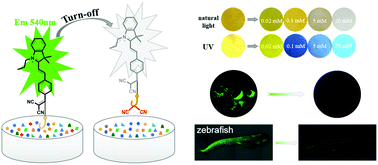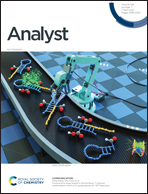A Michael addition reaction-based fluorescent probe for malononitrile detection and its applications in aqueous solution, living cells and zebrafish†
Abstract
It is highly desirable to detect malononitrile in organisms and human bodies owning to its inherent toxicity. With dicyanovinyl as the recognition site, a Michael addition reaction-based fluorescent probe Hcy-DCV was developed for malononitrile detection. A notable advantage of this probe is that it responds quickly to malononitrile without any additive to speed the sensing reaction. It has a good water solubility and the detection limit was determined to be 6.92 ppb in 100% aqueous solution. In particular, Hcy-DCV exhibited good selectivity towards malononitrile over other interfering substances including hydrazine and other active methylene compounds. The probe was applied successfully to quantitate malononitrile in pure water with satisfying recovery and relative standard deviation. Additionally, the ability of visualizing malononitrile by using probe-coated strip papers was displayed, which may facilitate the on-site detection of malononitrile. Moreover, the bioimaging of malononitrile in living H1975 cells and zebrafish larvae was also demonstrated. All the experimental results suggested the potential of Hcy-DCV for practical detection of malononitrile in both environmental and biological samples.



 Please wait while we load your content...
Please wait while we load your content...